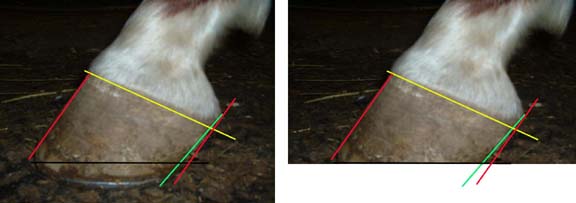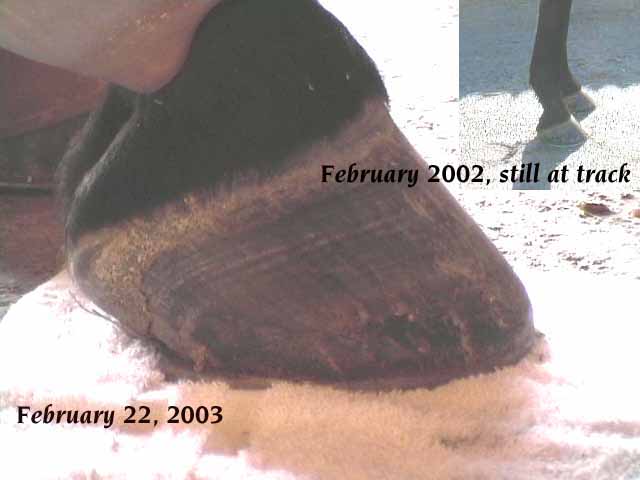Yes, NRB, you have the right idea. ![]()
Just to help clarify in case others are confused, here is EventGurlie’s pic. This is very generalized in that I am using angles to indicate where the correct shape of the foot should fall…since every horse is different and we don’t know what’s inside, we know that these angles are not perfect, but give us a guide to discuss a better shaped foot.
Note that the heel is only slightly underrun (compare red line (ideal) to green (actual). See how the two lines are much closer as the heel is shortened? And note that the hairline doesn’t look to bad, but diverges from the straight as the heel runs forwad and pulls it. Then, if I take and put a line across where I want to start getting the heels more correctly placed…note how the heel shortens, and the whole foot starts to come into a better alignment. I would also need to move the shoe back toward the red line to offer support for the heels.
The frog: according to Bowker’s and other studies, the frog should touch the ground when the horse is standing on a hard surface. It should probably be sharing the weight with the two points on the heel where the wall hooks into the bars. In order for this to happen, it would tend to be slightly higher than the wall (as it compresses). But, most agree that it should taper down to meet the sole and is only higher in the rear most part of the foot. An important point in having the frog touch the gound is that the propiorceptors are mostly located in the frog and rear of the foot. These are the sensors that send messages to the brain (actually the spine) to tell the horse where and how he is stepping.
Your concerns about the coming wet weather and bruising are understood. However, if the spacial orinetation of the coffin bone is correct, then you shouldn’t experience bruising. But, in most cases, even if the coffin bone is correctly oriented to the gound plane, in many cases of imbalanced feet, it will reside to low in the foot and thus already be applying pressure to the corium, which is enhanced by the sole softening caused during wet weather…resulting in bruising. I know that doesn’t help you now, but if you plan to leave the horse barefoot, then this should be a goal.
Yes, a healthy hoof should show some concavity, however, not all feet are the same and some (like drafts) are more genetically prone to being flatter. But, generally, the healthier the foot, the stonger the interior attachments, the higher the coffin bone sets in relationship to the ground plane, and the the more concavity can be attained. You are right, if you can flex the sole with your finger, it is generally to thin. This, however, can generally be fixed and a thicker sole is more the result of a balanced trim and environment rather than genetics.
You raise an important issue about the wild horse studies. But, I think that those who study would generally be the first to agree that wild doesn’t = domestic (there are some that don’t agree, and so far from what I see, they have not been as successful in their efforts as those who agree). The important thing was to note what parts of the foot were used (and how) to support the coffin bone/foot. When these particular principles are applied correctly, it is apparent from anecdotal evidence, as well as recent studies, that addressing these differences in domestic horses are generally all that is needed to create a much healthier, stronger, and correctly formed foot. Their attempt has not been so much to match form as to match function. I think that few would debate that alignment of the boney column and proper functioning of internal structures to provide optimal shock absorbtion, correct placement of breakover to provide optimal movement, or correct spacial orientation of the coffin bone to prevent it from pressing on the solar corium (thus thinning and even bruising the sole) are, or should be, that different between domestic and wild horses.
Well…just my opinion, but I admit bias because I see these methods fixing bad feet nearly every day. ![]()
Opps…forgot to attach the pic
OK…that was freakin’ huge…I’ll try again.
Proud member of the * Hoof Fetish Clique *



 ive found a farrier up here who im happy with who has shod him once, and is again working on evening up the feet. now this horse has never, and will never be the greatest mover in the world, but i have noticed since i have him back in work (he was out of work for ~6 months) that he feels slightly uneven in the right front. defintly not lame at all but just slightly different. back during his soundness exam, i wondered if the slight something in the right front was due to his foot, and i also wonder if it is now.
ive found a farrier up here who im happy with who has shod him once, and is again working on evening up the feet. now this horse has never, and will never be the greatest mover in the world, but i have noticed since i have him back in work (he was out of work for ~6 months) that he feels slightly uneven in the right front. defintly not lame at all but just slightly different. back during his soundness exam, i wondered if the slight something in the right front was due to his foot, and i also wonder if it is now.